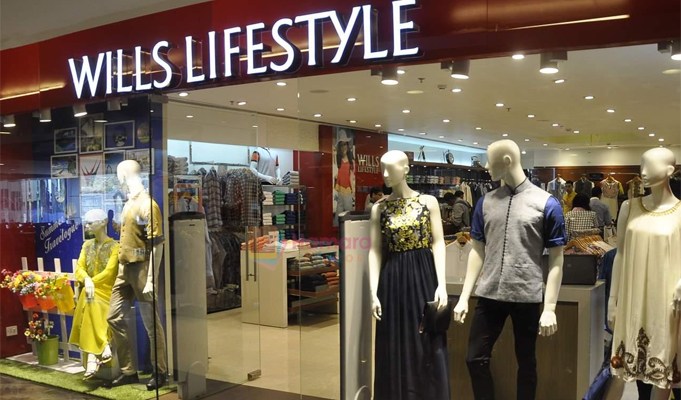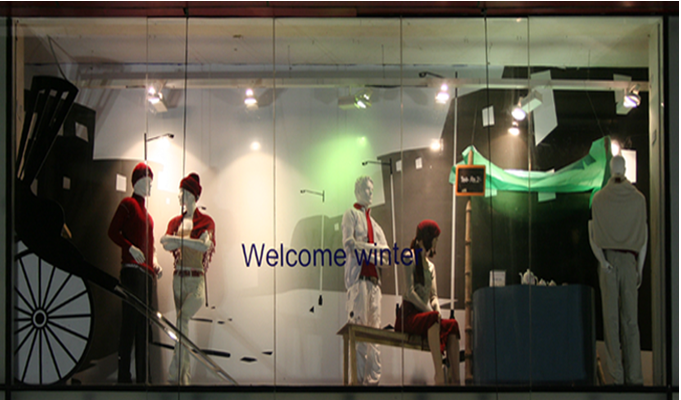Good visual merchandising must have a “wow” element – customers who come to a store should feel happy because ultimately every retailer has opened the store for the customer, not for his own benefit.
Here is the list of retailers who have reaped benefits from Visual Merchandising:-
1. RAYMOND

With the Omnichannel mantra gaining ground in India and consumers living in parallel digital and physical worlds, brands are fast turning the spotlight on their merged strategies, and Raymond is no different.
The textile and apparel major is constantly innovating and re-innovating to attract more and more consumers. Last year, in a stunning display of visual merchandising, Raymond created a “live” display window to showcase a new fabric, Techno Stretch, at JK House in Mumbai.
“We were launching our Techno Stretch fabric and needed a visual display that brought to life its key feature – that is stretch. We created a larger than life backdrop against which we got two artists posing as mannequins to wear our techno stretch outfits and break into dance forms that tested the ultimate stretch of the fabric. This act created a huge talking point at windows there by increasing walk-ins and overall sales of the offering,” says Shradha Kurup, Head, VM, Raymond Ltd.
She strongly feels that for any kind of VM to increase footfalls, it has to create an engagement at the point of sale. She feels windows should amplify and intrigue through messaging and treatment, thereby creating curiosity and walk-ins.
2. RAYMOND KHADI

At Raymond, Khadi, the newest theme is ‘The Story Respun’. Through VM, the brand has effectively brought to life the key features of khadi in stores, highlighting its features through window displays, in-store planograms and mannequin styling.
Kurup says, “Khadi – The Story Respun is about showcasing khadi fabric in its new trendy avatar whilst retaining its core proposition. The Charkha has been showcased as an abstract sculpture form, placed in the window against a pure organic backdrop made of canvas. The simplicity and elegance of the fabric is translated through the use of media that is similar in nature and hence brings out the features of this beautiful fabric seamlessly. In-store, we have created units that house the charkha as well as mediums like canvas and jute rope to create backdrops against which we communicate the features of design and fabric to all customers.”
3. BEING HUMAN

“We did a campaign with Denim Bloggers, who are culturally rich young professionals and are doing different things in life – not just related to fashion. Our marketing and promotions team collaborated with bloggers who were fashion forward, food enthusiasts, travel buffs to know what their individual styles were, rather than just design our own pieces. We then curated these styles and displayed them in our stores,” says Karan Berry, Creative Head, Being Human.
The campaign resulted in a lot of increase in footfalls for stores around the country. The brand also works hard to ensure that the VM displays in store are replicated online, so that customers can acquire the same styles offline or online. This has greatly helped increase their revenues.
4. PEPE JEANS

The year’s focus continues to be on the brand’s premier customization service – Pepe Jeans Custom Studio. It allows customers to step into the design seat and customize their denim in a few easy steps. Customers can choose from laser prints, cool studs & fastenings – be it buttons, rivets or tacks; chose to distress their denims or add in colours and tassles.
“To drive awareness and create excitement about the in-store service, we worked on developing window displays that had fun elements which creatively represented this unique customization service. Our objective was to try & communicate the variety of services that a customer can explore at the Pepe Jeans custom studio. We designed a variety of jackets and denims to showcase the lazer printing, ripping and stud work which worked perfectly as it gave potential customers an idea on how to design their denims,” says Tejaswini Nigam, HEAD VM, Pepe Jeans India.
“Similarly, we also used fun props to highlight this service such as wooden scissors, zippers, spools of various shades of indigo threads, jars with a colorful assortment of buttons, studs, embroidery patches, tassles, and fabric colours. This artistic display helped us to create curiosity among walk-ins and encourage them to explore this unique customization service from Pepe Jeans,” she adds.
The set-up was seen at stores wherein the custom studio service is available, namely Mumbai, Delhi Kolkata & Bangalore.
Pepe Jeans also launched Powerflex denims with a powerful display window.
“The aim was to showcase the high stretchability and durability of the product in a distinctive way. We designed a special mannequin in an upside-down posture (just like a handstand) to highlight the stretch feature as well as showcase the fit. The window display was seen in over 100 Pepe Jeans stores across India. With this, we were able demonstrated the denim’s ability of being able to fit and stretch in a seamless way. This helped generate a great deal of curiosity amongst customers,” explains Nigam.
In the past, Pepe Jeans has also created LED signages for its kidswear selection, apart from designing a camp/ picnic setup complete with denim fabric to appeal to young shoppers at select kids stores in Mumbai, Kolkata and Ahmedabad.
A larger than life denim tree with flowers and butterflies all made of denim displayed at Quest Mall, Kolkata and special light boxes with an abstract representation of Goddess Durga in over 50 stores to mark the festival of Durga Puja in Kolkata are some of the more memorable window displays from the brand.
5. BAGGIT

At Baggit, the current VM theme is inspired by travel. Elaborating on this, Nina Lekhi, MD & Chief Design Curator, Baggit says, “Indian consumers are becoming global in terms of fashion and travelling. Today travel is more than just a breather from their monotonous, daily life. As a brand we believe one must travel smart and sophisticated, hence, this season travel dominates our visual merchandizing theme. With this we aim to target the young and the global consumers travelling with and without family, across the globe.”
Products are displayed at the strategic focal points (window and inside the store) to make the consumers experience the bags from a travel point of view.
6. WILLS LIFESTYLE

Another brand that has travel as its core theme is Wills Lifestyle and the theme is titled ‘Caught at the Bay’.
Akash Ashesh, Country Head, Visual Merchandiser, ITC – LRBD says, “The theme is inspired by travel diaries as the main story where the heart meets the soul, where there is happiness, relaxation, euphoria, where vacation is the key word.”
7. BIBA

BIBA, one of India’s leading ethnic wear brands, currently has its windows decked out in the theme of its Spring/Summer 2018 marketing campaign Flowers of the World.
A world map adorns closed-back windows fitted with individually constructed silk flowers. On open windows, floral swings made of rope and silk flowers suspend from ceilings, and artificial grass mats cover the floor, with carefully positioned individual flowers and petals.
Inside the store, Flowers of the World shopping bags with silk fuchsia roses deck high-point shelves on wardrobe units and in trial rooms, mirrors are festooned with swags of floral vines.
8. AEROPOSTALE

Brand Aeropostale’s current theme is #NOLIMITS – with a focus on Spring’18.
Sumit Dhingra, COO, Arvind Fashions Limited explains, “We believe that the youth today are constantly breaking their own boundaries and exploring unchartered territories. Being a youth fashion brand, Aeropostale connects with the ideology of pushing your limits and hence, we have adopted the #NOLIMITS theme at our stores.”
Like all premium brands, CREYATE has VM guidelines to define its retail space planning format. A centrally-led VM team conceptualizes and assesses the execution quality in alignment with the seasonal communication, based on stringent precepts upheld for rotating samples, accessorizing samples, mannequins and accessory unit displays.
In terms of product display, the VM is mostly limited to ‘made to order’ samples kept for trial sessions as well as accessories offered for purchase at the stores. Execution is handled by store-based VM executives as well as a network of VM vendors across cities.
“We follow a seasonal VM calendar wherein the display is changed once in six months at all stores, the displays changing according to the season. Geographies and weather play a prominent role in our VM campaigns and the products that we display in our windows,” says Dhingra.
~ With Inputs from Sandeep Kumar & Surabhi Khosla ~







